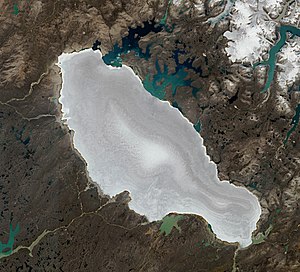Barnes-Eiskappe
| Barnes-Eiskappe | ||
|---|---|---|
 Sentinel-2 Satellitenbild der Eiskappe (2019) | ||
| Lage | Baffininsel in Nunavut (Kanada) | |
| Typ | Eiskappe | |
| Länge | 150 km [1] | |
| Fläche | 6000 km² [2] | |
| Höhenbereich | 1120 m – 500 m | |
| Eisdicke | max. 500 m [1] | |
| Koordinaten | 70° 0′ N, 73° 30′ W | |
Als Barnes Ice Cap oder Barnes-Eiskappe wird eine Eiskappe im Nordosten Kanadas auf Baffin Island bezeichnet. Sie umfasst eine Fläche von 6000 km², doch verliert sie seit einiger Zeit beschleunigt an Höhe.[2] Bei der Barnes-Eiskappe handelt es sich um eines der ältesten bis mehr als 20.000 Jahre alten Eisrelikte der letzten Kaltzeit[3] und zugleich ist es eines der zehn größten Kanadas.
Erhöhte Abschmelzrate
Allein zwischen 2004 und 2006 lag der Höhenverlust bei 1,0±0,14 m pro Jahr. Zwischen 1970 und 1984 hatte dieser Wert noch bei 0,12 m pro Jahr gelegen. 1984 bis 2006 war er bereits auf 0,776±0,35 m gestiegen. Dies hängt mit der verlängerten Zeit zusammen, in der pro Jahr das Eis schmilzt. Lag diese Zeit in den Jahren 1979 bis 1987 noch bei 65,6 ±6 Tagen, so stieg sie bis gegen Ende der Messperiode 2002 bis 2010 auf 87,1 ± 7,8 Tage.[4] Im März 2011 fand eine zehntägige Untersuchung des Eisfeldes statt, das bis dahin hauptsächlich per Satellit vermessen worden war. Der Anteil derartiger Eiskappen am Anstieg des Meeresspiegels wird seit mehreren Jahren untersucht. Während der letzten 5000 Jahre war die sommerliche Durchschnittstemperatur um 2,7 °C gesunken. Es erwies sich, dass im Sommer 2013 die seit 44.000 Jahren höchste Abschmelzrate erreicht wurde.[5]

Literatur
- Kurt A. Refsnider, Gifford H. Miller, Marilyn L. Fogel, Bianca Fréchette, Roxane Bowden, John T. Andrews, G. Lang Farmer: Subglacially precipitated carbonates record geochemical interactions and pollen preservation at the base of the Laurentide Ice Sheet on central Baffin Island, eastern Canadian Arctic. In: Quaternary Research Bd. 81, Nr. 1, Januar 2014, S. 94–105.
Anmerkungen
- ↑ a b Brian Hanson: Thermal response of a small ice cap to climatic forcing. In: Journal of Glaciology Bd. 36, Nr. 122, 1990, S. 49–56.
- ↑ a b William Sneed, Roger Hooke, Gordon Hamilton: Thinning of the south dome of Barnes Ice Cap, Arctic Canada, over the past two decades. In: GeoScienceWorld Bd. 36, Nr. 1, 2008, S. 71–74.
- ↑ Canada's oldest ice formation melting at alarming rate, scientists say, CanWest News Service, 9. Januar 2008.
- ↑ Florent Dupont, Alain Royer, Alexandre Langlois, Alicia Gressent, Ghislain Picard, Michel Fily, Patrick Cliche, Miroslav Chum: Monitoring the melt season length of the Barnes Ice Cap over the 1979–2010 period using active and passive microwave remote sensing data. In: Hydrological Processes Bd. 26, Nr. 17, 2012, S. 2643–2652
- ↑ Gifford H. Miller, Scott J. Lehman, Kurt A. Refsnider, John R. Southon, Yafang Zhong: Unprecedented recent summer warmth in Arctic Canada. In: Geophysical Research Letters Bd. 40, Nr. 21, 2013, S. 5745–5751.
Auf dieser Seite verwendete Medien
Autor/Urheber:
- Canada_Nunavut_location_map-lambert_proj.svg: Flappiefh
- derivative work: NordNordWest
Positionskarte von Nunavut, Kanada
Barnes Ice Cap, Baffin Island, Canada
Natural-colour image of the Barnes Ice Cap, a bowling-pin-shaped glacier on Canada’s Baffin Island. The image shows a portion of the Barnes Ice Cap near its south-eastern end. Gee Lake sits immediately off the glacier. Resembling growth lines on a clamshell, striations run roughly east-west on the glacier surface. Rather than appearing pristine white, the ice and snow is banded with dust layers spanning time periods that dwarf a human life. By studying ice cores containing such dust layers, climatologists can find clues to ancient climates. Ted Scambos of the National Snow and Ice Data Center observes that although the ice cap is essentially flat, it appears to undulate, thanks to ridges cut by melt streams running off the glacier. In this summertime shot, the glacier is mostly snow-free except for a band of snow along the edge near Gee Lake. As winter returns, snow will once again cover the glacier, the surrounding land, and the lake.



